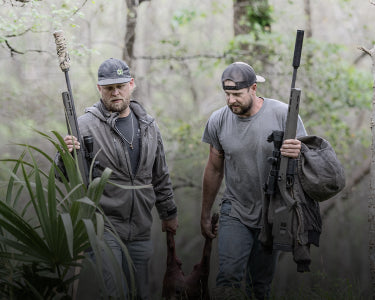Deciding to buy your first riflescope is a good choice. Modern scopes make hunting, competition, target and long-range shooting easier and more accurate.
However, there is almost an endless amount of choice. How is one supposed to choose? This how-to guide to buying a riflescope will help you narrow your choices.
-
Magnification

The Sightmark Latitude 8-32x60mm long-range scope has an elevation range of 110 MOA.
Magnification is one of the most important aspects of a riflescope. Magnification is the range to which you can multiply the naked eye’s vision. In other words, a scope with 2x magnification power is twice the power of your unaided eye.
Magnification is referred to in power-level increments and is represented by the first numbers in a riflescope’s name. For example, on a variable zoom 1-4x32mm scope, the magnification would be 1-4x what the naked eye sees. On a fixed scope, like a 4x32mm scope, the magnification is fixed at 4x what the human eye can see.
Magnification is largely preferential. If you are a hunter who shoots moving targets under 100 yards, 3-9x would perform well. If you want to hit bullseyes from 750 yards, then a scope with a larger magnification range like 5-30x might suit your style.
Note: higher magnification settings mean the user will have a narrower ‘field of view’. For hunting scopes, this means when you’re magnified 2x, the field of view diametrically decreases by a factor of 2.
For fast-moving prey like hogs and varmint, you might want to consider a low-powered variable magnification riflescope to more easily manage the effects of magnification and decreased field of view.
-
Objective Lens Size
The objective lens size is the diameter of the lens closest to the barrel of the rifle, and farthest away from the stock of the rifle. The objective lens diameter is the number after the x in the rifle scope’s title. For example, a 1-4x32mm scope has an objective lens with a diameter of 32mm.
The size of your objective lens affects how much light the scope will be able to transmit. A larger objective lens lets in more light, producing a brighter image, but at the expense of being heavier than a scope with a smaller objective lens.
-
Weight

The 1-6x magnification range makes the Citadel CR1 ideal for both CQB and mid-range.
Weight is a factor you want to consider before you make your purchase. Think about where you will be doing most of your shooting. If you are shooting long distances at the range where you’ll have a bipod or sandbags to fire your rifle from, then a heavier scope probably won’t affect you very much.
If you are stalking deer in the mountains and have to do a lot of hiking in between shots, it could be beneficial for you to choose a lighter riflescope since constantly raising and holding a heavy rifle takes its toll after some time.
-
Elevation/Windage Adjustment
Windage and elevation adjustment turrets are used to adjust the position of the bullet’s impact. Windage adjustments have the ability to move the bullet’s point of impact to the left or right in relation to the reticle. Elevation adjustments are used to move the bullet’s point of impact up or down.
Scope adjustments are either made in minute of angle units or milliradians. For the beginner hunter, once you sight in your rifle, the windage and elevation turrets won’t need to be adjusted again. These adjustments are extremely helpful for tactical shooters making long-distance shots.
-
Lens Coating
Next to the objective lens size, lens coatings are the most important aspect of light transmission. When looking through the scope, you want to see the brightest and clearest image possible. This is affected by the amount of reflected light coming through the lens and the amount of light transmitted through the lenses.
The goal of optical coatings is to reduce the glare and the loss of light caused by reflection. More coatings generally result in better light transmission. There are four main categories of optical lens coatings:
- Coated – at least one of the lenses has a single layer of anti-reflective coating
- Fully Coated – on every air-to-glass lens (the outer lenses) there is a single layer of anti-reflective coating
- Multicoated – at least one of the lenses has multiple layers of anti-reflective coating
- Fully Multicoated – multiple layers of coating have been put on all air-to-glass lenses
Keep in mind that with higher quality comes a higher price; however, spending the extra money to get quality coatings can greatly impact your shooting experience.
-
Reticle

Also known as the “crosshair,” the reticle is the part of the riflescope that predicts where the bullet will go. Looking at a reticle through the riflescope is similar to lining up your shot in iron sights. Reticles, like eye relief, are a matter of preference and a huge variety is available for shooters to choose from. On a very basic level, the crosshairs’ thickness is going to affect the precision of your shot.
Larger reticles are easier to see in low-light situations, but can sometimes dwarf or cover up the target if the target is far away. Thinner crosshairs allow the shooter to be more precise but are more difficult to see in low-light.
Many reticles come with posts or scales on their crosshairs. These small ticks are minute of angle or milliradian measurements used to compensate for the bullet’s drop at greater distances. However, not every tick mark is always accurate at any range, because the reticle can be affected by what focal plane it is set in.
-
Focal Plane
Focal plane can be found in two forms—first or second. In a second focal plane riflescope, the reticle is at the end of the erector tube near the end closest to the butt of the rifle. This means that the magnification is changing behind the reticle in relation to the shooter, so the reticle image maintains its original size.
The reticle is not always proportional to the target, only at a certain magnification (often the greatest magnification possible). As you zoom in, the reticle takes up more and more of your vision, appearing larger though it is actually staying the same size it always was.
In a first focal plane riflescope, the reticle is located in the front of the erector tube—meaning when you zoom in with the scope, it also zooms in on the reticle as well. This creates a proportionate changing of size between the target and your reticle.
Since everything is proportional, the reticle’s tick marks are accurate at all ranges, not just the most zoomed-in range. First focal plane riflescopes are more expensive in general, but allow the shooter to make adjustments much faster than changing the windage or elevation adjustments.
-
Tube Size
Tube size is important to know for a beginner because you want to be able to use your scope after you buy it, meaning you need the right size mounting rings for your scope. Tubes can be found generally in two sizes: 30mm and 1 inch. Other than increasing the adjustment range internally, neither offers greater benefits than the other—a larger tube doesn’t mean it lets more light in.
However, you will need to know what size tube you have so when you go to use your scope you aren’t stuck trying to put 1-inch mounting rings on a 30mm tube. If you live in the United States, you might want to remember that more riflescopes are built with one-inch tubes than are not. However, once again, tube size is entirely preferential.
Do you have further questions about riflescopes? Leave them in the comment section and we will do our best to answer them.
Big Thanks to John Shellenberger for contributing to this blog!
Click here to find your new riflescope!
Frequently Asked Questions
What magnification do I need for my riflescope?
The magnification you need depends on your shooting activity. For close-range or fast-moving targets, a 1-4x or 3-9x scope is ideal. For long-range shooting, something like a 5-30x scope is more suitable.
What does the objective lens size affect?
The objective lens size determines how much light enters the scope. A larger lens provides a brighter image but adds weight to your setup.
Why is scope weight important?
Scope weight matters based on how you shoot. Heavy scopes work well for stationary, supported shooting. For mobile hunting, lighter scopes reduce fatigue and are easier to carry.
What do windage and elevation turrets do?
Windage adjusts bullet impact left or right, and elevation adjusts it up or down. They're essential for dialing in precision, especially at longer distances.
How do lens coatings improve image quality?
Lens coatings reduce glare and increase light transmission. Fully multicoated lenses offer the best clarity and brightness, though they often come at a higher price.
What kind of reticle should I choose?
Reticles vary in style and thickness. Thicker ones are easier to see in low light, while thinner ones allow more precise aiming. Some have marks for range or windage compensation.
What’s the difference between first and second focal plane scopes?
First focal plane (FFP) reticles scale with magnification, so range marks stay accurate at any zoom. Second focal plane (SFP) reticles remain the same size, so markings are only accurate at one magnification level.
What tube size should I get for my scope?
Common tube sizes are 1 inch and 30mm. Make sure your mounting rings match the tube size. The choice mostly affects adjustment range, not light transmission.





4 comments
You made an interesting point when you talked about how scopes with large reticles are easier to see in low-light situations. My brother wants to go deer hunting this summer, but he usually can only go in the evenings. It seems like my brother would want to get a scope with a large reticle so that he can see the deer in the low light. https://kentonindustries.com/pages/custom-turrets
You got my attention when you said that before making a purchase, you must consider the weight of the rifle scope that you will need. My husband and father are planning to go on a hunting trip on the 30th, so they are looking to purchase hunting rifles over the weekend. I will be sure to share your blog with them so they can be guided well in purchasing a rifle and a scope. https://countryboysports.com/index.php/firearms/long-guns-rifles-shotguns/
My older brother loves to go hunting and he wants to improve his game by investing in a rifle scope. It is good to know that you should choose a scope based on its weight and the type of hunting you plan on doing. I will share this with my brother so he can find a scope for his rifle that is the perfect weight for his hunting trips. https://alaskaarmsllc.com/collections/cz-scope-rings
It sure was helpful when you said that you must consider the weight of a riflescope before making a purchase. As you said, a lighter riflescope could benefit you if you are talking deer in the mountains. This is something that I will share with my husband since he wants to shop for gun optics. He is into deer and animal hunting, and I could imagine the need for him to choose gun accessories based on his goals. https://www.aec-outdoors.com/catalog/optics